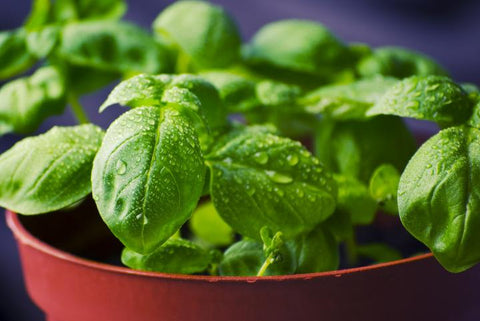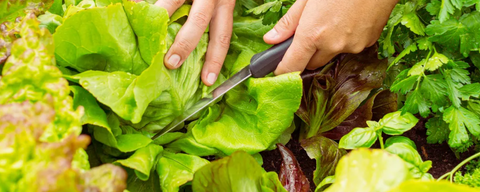Looking to bring a pop of color to your garden this season? The vibrant blue star fern is the perfect plant to add a unique touch of elegance and beauty. With its striking blue-green fronds and low-maintenance care, it's ideal for both beginners and seasoned gardeners alike. In this post, we’ll explore why the blue star fern should be your next garden addition.

What Makes the Blue Star Fern So Special?
The Striking Blue-Green Color and Its Appeal
One of the most captivating features of the Blue Star Fern is its unique blue-green color. The rich, cool tones of its fronds set it apart from other ferns, which typically feature greener hues. This stunning coloration brings a touch of serenity and sophistication, making it a perfect plant for both modern and traditional garden designs.
Understanding the Unique Shape of the Blue Star Fern Leaves
The fronds of the Blue Star Fern are what truly define its beauty. With their elongated, leathery texture and a gentle curve that evokes a feeling of movement, the leaves resemble star-shaped bursts, hence the name. The shape of the fronds creates a cascading effect that adds depth and dimension to your garden space, whether it's planted in the ground or in a hanging pot.
A Versatile Fern That Thrives in Multiple Environments
One of the Blue Star Fern's greatest strengths is its ability to thrive in different environments. It does equally well in shaded, humid corners of the garden as it does in containers on a porch or balcony. This fern can tolerate both warm temperatures and the occasional cooler nights, making it a perfect choice for a range of growing conditions. Whether it’s a low-light nook indoors or a partially shaded garden bed, the Blue Star Fern adapts beautifully.
Where to Plant Your Blue Star Fern for Maximum Impact
Best Locations for Growing Blue Star Ferns
The Blue Star Fern flourishes in shaded or partially shaded areas, making it ideal for areas with indirect light or dappled sunlight. Outdoor locations that provide shelter from direct afternoon sun are perfect for this plant. Whether nestled under a tree canopy or against the side of a building, it will thrive in these cooler, more humid microclimates.
How to Incorporate Blue Star Ferns Into Your Garden Design
For maximum impact, place Blue Star Ferns in groups or as focal points in shaded parts of your garden. Their bold, arching fronds can serve as a beautiful contrast to more rigid plants like hostas or ornamental grasses. If you want to create a natural, woodland-inspired garden, the Blue Star Fern can be combined with other ferns, creating a lush, multi-layered effect.
Ideal Companion Plants for Blue Star Ferns
Blue Star Ferns look stunning when paired with other plants that complement their cool tones and soft textures. Try planting them with contrasting evergreen shrubs, such as hostas or astilbes. For added dimension, combine them with flowering plants like impatiens or begonias, which thrive in similar light conditions.
How to Choose the Right Blue Star Fern for Your Garden
Selecting Healthy Blue Star Fern Plants
When choosing your Blue Star Fern, look for plants with vibrant, firm fronds that are free from discoloration or damage. A healthy fern should have a bright, blue-green hue and sturdy leaves, not limp or yellowing. Check the roots to ensure they are white and not dark or mushy, which could be a sign of rot.
Different Varieties of Blue Star Ferns and Their Characteristics
While the classic Blue Star Fern (Phlebodium aureum) is the most common variety, there are slight variations in size and color that may suit different garden styles. Some cultivars have deeper blue hues, while others are a bit more silvery. Consider your garden’s aesthetic and choose a variety that complements the surrounding plants.
What to Look for When Purchasing Blue Star Ferns
When purchasing a Blue Star Fern, make sure to inspect the plant thoroughly. Look for one that has a healthy, well-developed root system and no signs of pests or diseases. A fern that has already established a good root system will adapt more quickly to your garden, reducing the stress of transplantation.

Preparing the Soil for Your Blue Star Fern
The Importance of Well-Drained Soil
Blue Star Ferns thrive in well-drained soil, as they are susceptible to root rot in waterlogged conditions. This fern prefers soil that retains moisture but doesn’t hold excessive water. Ensure your soil has good drainage by amending it with sand or organic matter like compost, which helps retain just the right amount of moisture.
How to Amend Your Soil for Ideal Growing Conditions
If your soil is heavy and clay-like, consider mixing in some organic material like peat moss or perlite to improve drainage. For sandy soils, add compost to enhance the soil’s ability to retain moisture. This will create a well-balanced, fertile environment that supports the fern’s growth.
pH Levels and Soil Texture: What Blue Star Ferns Prefer
The ideal pH range for blue star ferns is between 5.5 to 7.0, which is somewhat acidic as opposed to neutral. The texture should be loose and rich, allowing the roots to spread out and access nutrients easily. Soil that is too alkaline or too compact will hinder the fern’s growth and may lead to nutrient deficiencies.
Planting Blue Star Fern: Step-by-Step Guide
How to Properly Plant a Blue Star Fern
Dig a hole that is at least twice as big as the root ball to begin. Gently remove the fern from its container and place it in the hole, ensuring that the top of the root ball is level with the surrounding soil. Fill in the space around the roots with your amended soil, and press down lightly to remove air pockets.
Spacing and Depth Tips for Healthy Growth
When planting multiple Blue Star Ferns, space them at least 12 to 18 inches apart. This ensures that the fronds have room to spread out and allows air circulation, reducing the risk of disease. The depth of the hole should match the root ball’s height, as planting too deep can lead to root rot.
Watering and Mulching Techniques for Blue Star Ferns
Water the fern well after planting to let the dirt settle around the roots. Blue Star Ferns prefer consistently moist soil but be careful not to overwater. Mulch around the base of the plant with organic materials such as bark or wood chips to help retain moisture and keep the soil temperature stable.
Caring for Blue Star Ferns: Essential Maintenance Tips
How Much Water Do Blue Star Ferns Need?
Blue Star Ferns prefer a moderate amount of moisture. Keep the soil evenly moist but not soggy, especially during the growing season. If grown in containers, ensure the pot has proper drainage to prevent water accumulation at the bottom.
Ideal Temperature and Humidity Levels for Thriving Ferns
These ferns thrive in temperatures between 60°F and 75°F (15°C to 24°C). They also love humidity, so if you live in a dry climate, consider using a humidifier or placing a shallow tray of water near the plant. Outdoor ferns naturally enjoy the moisture in shaded, cool environments.
Pruning and Shaping Your Blue Star Fern for Optimal Growth
To maintain the health and appearance of your Blue Star Fern, prune away any dead or damaged fronds. This will help the plant conserve energy and encourage new growth. Use clean, sharp scissors to avoid causing harm to the fern, and be gentle with the delicate fronds.

Feeding and Fertilizing Your Blue Star Fern
The Best Fertilizer for Blue Star Ferns
Blue Star Ferns benefit from a balanced fertilizer, such as a 10-10-10 NPK formula. During the growing season, feed your fern every 4 to 6 weeks to encourage lush growth. A slow-release granular fertilizer or liquid fertilizer diluted to half strength works well.
How Often Should You Fertilize Your Fern?
Fertilize your Blue Star Fern once a month during the active growing season (spring to summer). Reduce or stop fertilizing during the fall and winter when the fern is in a dormant phase, as it requires less nourishment during these months.
Organic and Natural Fertilizer Options
If you prefer natural fertilizers, compost, or well-aged manure are excellent choices. They release nutrients slowly, providing a steady supply of nourishment to the fern without the risk of burning its roots.
Common Pests and Diseases That Affect Blue Star Ferns
Identifying and Treating Common Pests Like Aphids and Mealybugs
Blue Star Ferns can sometimes fall victim to pests like aphids and mealybugs. These pests suck sap from the fern, weakening the plant. If you spot them, treat your fern with insecticidal soap or neem oil to keep them at bay.
How to Prevent Fungal Infections and Root Rot
Root rot and fungal infections are common problems for ferns, especially if the soil remains too moist. To prevent these issues, make sure your fern has well-draining soil, and avoid overwatering. A fungicide can also help control fungal infections if they occur.
Dealing with Fern-Specific Issues and How to Fix Them
Ferns can be prone to problems like yellowing leaves or stunted growth due to poor light, overwatering, or nutrient deficiencies. To correct these issues, adjust care practices—ensure the fern is in a suitable environment with proper light and drainage.
Troubleshooting: What to Do When Your Blue Star Fern Isn’t Thriving
How to Diagnose and Fix Common Blue Star Fern Problems
Check your fern’s care conditions if it’s not thriving. Yellowing or browning fronds can signal overwatering or insufficient light. Adjust watering practices or move your fern to a brighter, more suitable location. With the right changes, your fern should bounce back in no time.
When to Seek Professional Advice for Your Ferns
If your Blue Star Fern's condition doesn't improve after adjustments, it might be time to consult a plant specialist. They can help diagnose underlying problems such as pests, diseases, or soil issues that require professional intervention.
Seasonal Adjustments That Can Revive a Struggling Fern
In the winter, reduce watering and make sure the fern is in a cool, but not freezing, location. If you’re keeping your fern inside, lower the humidity slightly to mimic outdoor conditions. With these small seasonal shifts, your fern will be set for a healthy recovery.

The Blue Star Fern is a captivating plant that brings life and elegance to any space. With its unique foliage, ease of care, and eco-friendly benefits, it’s an ideal choice for any gardener looking to enhance their outdoor or indoor spaces. Whether you’re planting it in a shady garden bed or showcasing it in a decorative pot, the Blue Star Fern will undoubtedly become a standout feature, blending beauty and functionality in your landscape.









